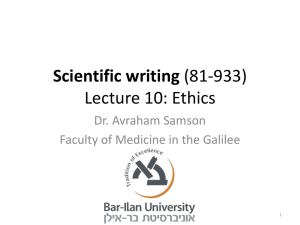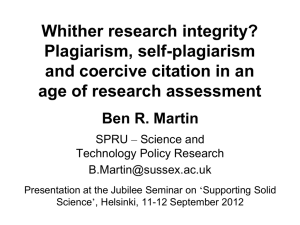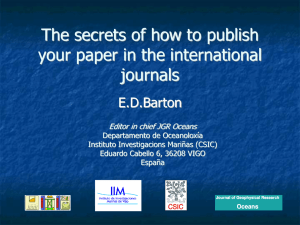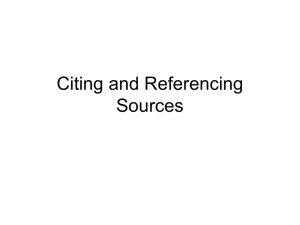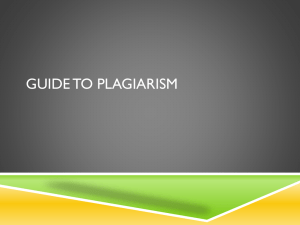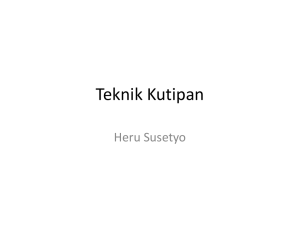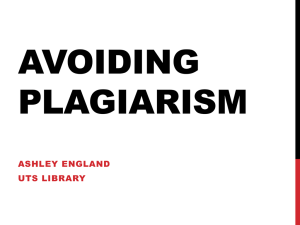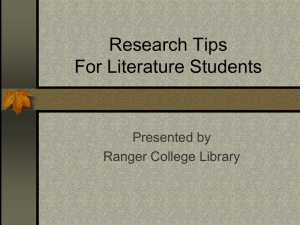Self Plagiarism in the Sciences
advertisement
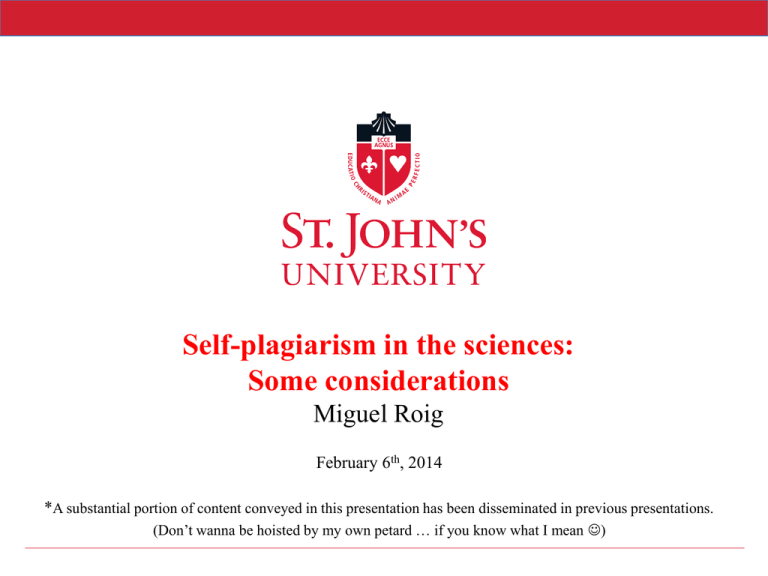
Self-plagiarism in the sciences: Some considerations Miguel Roig February 6th, 2014 *A substantial portion of content conveyed in this presentation has been disseminated in previous presentations. (Don’t wanna be hoisted by my own petard … if you know what I mean ) Plagiarism and Self-plagiarism • Plagiarism (stealing, kidnapping) – Presenting the work of others (e.g., ideas, words, images, design/structural properties, data, processes, musical notes) as one’s own. • Self-plagiarism – Controversial term. Is it possible to steal from oneself? – Passing off our own previously disseminated work (e.g., text, data) as new content. Self-plagiarism: As Academic Dishonesty • “Self-Plagiarism – The use of an essay or report for one course to satisfy the requirements of another course. A student must receive the instructor’s approval to use a previously completed assignment. If you want to use similar assignments to satisfy the requirements of two related courses, you must receive approval from all of the instructors concerned”. http://webs.calumet.purdue.edu/integrity/dishonesty/definiti ons-plagiarism/ Self-plagiarism: As Academic Dishonesty • “The act of plagiarism can be committed deliberately, as in purchasing a research paper from a commercial source (term paper mill), "borrowing" a completed paper from a student who had previously taken the same class, having someone else write a paper for you, or by downloading material from the Internet and submitting it as your own work. It can even be submitting a paper that you prepared for one class as fulfillment for an assignment in another class without receiving permission from your instructor. The latter is a form of "self plagiarism." http://www.una.edu/library/help/plagiarism-students.html. Self-plagiarism: As Academic Dishonesty • “Related to plagiarism is the notion of self-plagiarism, or using material for one assignment for another assignment as well. This is also sometimes referred to as “double-dipping” or recycling assignments and is another form of academic dishonesty. While this is sometimes permissible, especially if the student will be doing a larger project or greater work in order to fulfill more than one assignment, the permission of each affected instructor must be obtained”. http://academicintegrity.buffalo.edu/faq/index.php. Self-plagiarism: As Academic Dishonesty Most university policies that cover self-plagiarism address the issue of reusing entire papers from one course to another. But what about reusing portions of papers? How much is too much? • As instructors, how much covert recycling (without attribution) would we be willing to accept? • • • • Three quarters of a previously submitted assignment? Half of the previously submitted assignment? How about a quarter of the assignment? Three paragraphs? • The expectation is for students to always submit original work. • Shouldn’t the same expectation be applied to us? Why is self-plagiarism ethically problematic? • The reader-writer contract: – In most situations and unless we indicate otherwise, readers of our work assume that the material they are reading is: • Accurate. • Original (we wrote it!). • New (hasn’t been submitted/published before). Self-plagiarism as research misconduct Self-plagiarism as research misconduct? • Research Misconduct: - Fabrication, falsification, and plagiarism. Self-plagiarism does not generally fall under the definition of research misconduct by the federal agencies*. Self-plagiarism as research misconduct? * ORI often receives allegations of plagiarism that involve efforts by scientists to publish the same data in more than one journal article. Assuming that the duplicated figures represent the same experiment and are labeled the same in both cases (if not, possible falsification of data makes the allegation significantly more serious), this so-called “selfplagiarism” does not meet the PHS research misconduct standard. However, once again, ORI notes that this behavior violates the rules of most journals and is considered inappropriate by most institutions. * Dahlberg, J. (September, 2007). ORI Retains Its Working Definition of Plagiarism under New Regulation. ORI Newsletter Types of self-plagiarism • Duplicate (triplicate, quadruplicate) publication. • Redundant publication. – Augmented publication. • Segmented/Piecemeal/Salami publication. – All of these practices are acceptable AS LONG AS the reader is made aware of the origin of the earlier material (OVERT as opposed to COVERT duplication). • Most journals are only interested in original material. Self-plagiarism: How extensive is the problem? Empirical evidence for self-plagiarism • Schein (2001) found that 14% of 660 articles represented “a clear form of redundant publication”. Schein, M. (2001) Redundant publications: from self-plagiarism to “Salami-Slicing”. New Surgery, 1, 139-140. Empirical evidence for self-plagiarism • von Elm, et al. (2004), reported that of 1,234 articles reviewed in the area of anesthesia and analgesia, 5% were duplicates that gave no indication as to the original publication. von Elm, E., Poglia, G., Walder, B. & Tramèr, M. R. (2004). Different patterns of duplicate publication. Journal of the American Medical Association. 291, 974–980. Many do not believe self-plagiarism is unethical • In a study of health educators, Price, et al. (2001) reported that 64% of their sample stated that self-plagiarism is an acceptable behavior Price, J. H., Dake, J. A., Islam, R. (2001). Selected ethical issues in research and publication: Perceptions of health education faculty. Health Education and Behavior, 28, 51-64. The danger of covertly self-plagiarized data • Tramèr, Reynolds, Moore, & McQuay (1997) demonstrated how a drug’s efficacy can be overestimated by the inclusion of covert duplicates. In these cases the end result could conceivably put people’s lives at risk by, for example, leading policymakers to make the wrong health recommendations Self-plagiarism from the journals’ perspective – Most journals caution against duplicate publication and other forms of self-plagiarism. – Some journals ask authors to submit similar papers that have already been published or that have been submitted elsewhere to determine the extent of possible overlap. – Some journals have limits in the amount of text overlap between articles and it can range between 15% to 30%. Why is self-plagiarism problematic? • It misleads others (e.g., hiring, promotion and, tenure committees about the true professional output of the candidate. • Covert self-plagiarism of data is tantamount to data fabrication. If they remain undetected, they distort the scientific record by either overestimating or underestimating a statistical effect (e.g., efficacy of a treatment). What about reusing portions of previously published text? Evidence of text reuse • Roig (2005) in an exploratory study examined 9 papers and reported that most of them engaged in limited text reuse. However, one of the papers had recycled more than 30% from a previously published paper published by the same author. • Bretag & Carapiet (2007) reported that 6 of 10 authors engaged in at least 10% of text reuse from at least one of their previous publications. What can be recycled and from where? • Is text recycling appropriate in any section of a paper? – Introduction • An entire previously published literature review? • Some sections of a review? How much? – Methods Sections (some can be very difficult to rewrite!) • Subjects • Equipment – What is the big deal? • Procedure – Do we really want to change that? – Results? (stock phrases) – Discussion? How much? • Short segments from each section? Guidance on self-plagiarism of text (It’s all over the place!) General Guidance • Acceptable reuse ranges from 10% (Iverson, et al., 2007) to 30% (Samuelson, 1994). Iverson, C, et al. (2007). American Medical Association Manual of Style. A Guide for Authors and Editors, 10th ed. NY: Oxford U. Press. Samuelson, P. (1994). Self-plagiarism or fair use. Communications of the ACM, 37(8):21–25, 1994. • Based on an informal poll of members of the World Association of Medical Editors, Kravitz and Feldman (2010) report a range of acceptable reuse of between 10 to 20%. Kravitz, R. L. & Feldman, M. D. (2010). From the Editors’ Desk: Self-Plagiarism and Other Editorial Crimes and Misdemeanors. J Gen Intern Med 26(1):1 Guidelines from selected journals • “The authors must describe in a cover letter any data, illustrations, or text in the manuscript that have been used in other papers that are published, in press, submitted, or soon to be submitted elsewhere” (Evolution and Development), http://www.blackwellpublishing.com/submit.asp?ref=1520541X • “At the time of submission, authors must describe in a cover letter any data, figures, or text in the manuscript that have been used in other papers” (Conservation Biology) http://www.conbio.org/SCB/Publications/ConsBio/Instructions / Self-plagiarism guidance • Recycling data and text from one’s own or others’ published manuscripts is not allowed, no matter what language or format the data are presented in. Exceptions are when an author subsequently submits data to an educational establishment as part of a thesis, or wants to re-use figures as part of a scientific review. If at all in doubt, authors should always request permission from the editor and, as a matter of record, always cite the source in any thesis or review Murphy, S. P., Bulman, C., Shariati, B., Hausmann, L. (2014). Submitting a manuscript for peer review – integrity, integrity, integrity Journal of Neurochemistry 'Accepted Article', doi: 19.1111/jnc.12644. Acceptable in Methods Sections? It depends … • “Anesthesia & Analgesia explicitly accepts self-plagiarism in the Methods section of a manuscript, but discourages it elsewhere”. Shafer, S.L. (2011) You will be caught. Anesthesia and Analgesia, 112(3), 491-3. • “While there are sometimes good reasons for reusing certain textual elements (particularly in the Methods and literature review), authors should be cautious and thoughtful in doing so” (2010). Acceptable in Methods Sections? • “ADA journals will allow authors to reuse concise and wellwritten literature reviews and methodology descriptions from their own previously published work, assuming such text is properly cited and noted to the editors at the time of submission …” (2012). • “Methods are reported that were not actually used. This most frequently occurs when an author has published similar methods previously and has devised a template for the methods section that is reused from paper to paper. Reproducing the template exactly is self plagiarism and can be misleading if the template is not updated to reflect the current research project”. Biros, M.H. (2009). Advice to Authors: Getting Published in Academic Emergency Medicine, http://www.saem.org/getting-published-advice. Acceptable in Methods Sections? • Please note that verbatim copying of entire paragraphs (even in the “Methods” section) whether from other authors’ or one’s own prior work is never tolerated (2010). Self-plagiarism guidance: COPE Use of similar or identical phrases in methods sections where there are limited ways to describe a common method, however, is not uncommon. In such cases, an element of text recycling is likely to be unavoidable in further publications using the same method. Editors should use their discretion when deciding how much overlap of methods text is acceptable, considering factors such as whether authors have been transparent and stated that the methods have already been described in detail elsewhere and provided a citation. http://publicationethics.org/text-recycling-guidelines Self-plagiarism guidance: APA • Ethics Code: 8.13 Duplicate Publication of Data – Psychologists do not publish, as original data, data that have been previously published. This does not preclude republishing data when they are accompanied by proper acknowledgment. • Publication Manual – Just as researchers do not present the work of others as their own (plagiarism), they do not present their own previously published work as new scholarship (selfplagiarism).” (p. 16). Guidance from the APA Manual What is YOUR interpretation? There are, however, limited circumstances (e.g., describing the details of an instrument or an analytic approach) under which authors may wish to duplicate without attribution (citation) their previously used words, feeling that extensive selfreferencing is undesirable or awkward. When the duplicated words are limited in scope, this approach is permissible. When duplication of one's own words is more extensive, citation of the duplicated words should be the norm. What constitutes the maximum acceptable length of duplicated material is difficult to define but must conform to legal notions of fair use. The general view is that the core of the new document must constitute an original contribution to knowledge, and only the amount of previously published material necessary to understand that contribution should be included, primarily in the discussion of theory and methodology. When feasible, all of the author's own words that are cited should be located in a single paragraph or a few paragraphs, with a citation at the end of each. Opening such paragraphs with a phrase like "as I have previously discussed" will also alert readers to the status of the upcoming material. If you tend to recycle significant amounts of text from your previous papers, why should YOU be concerned? Plagiarism detection services • In 2007, CrossRef (DOI registration service and Iparadigms (Turnitin.com) joined forces to create the CrossCheck plagiarism service. – Growing data base of major publishers, including, BMJ group, Elsevier, Springer, Taylor & Francis, and many others. Plagiarism detection • e-TBLAST – A tool for detecting text similarity. • Deja vu - is a database of extremely similar Medline citations (over 5,000 journals). Many, but not all, of which contain instances of duplicate publication and potential plagiarism. Self-plagiarism: Conference presentations Types of conference presentations • There are various types of conferences and various forms of presentations and types of content (original data, review, theoretical). – Posters – Papers – Symposia/round table discussions – Workshops – Keynote addresses – Invited addresses Self-plagiarism and conference presentations: Some considerations • Making the same presentation at multiple conferences. – Except perhaps for invited (review-type) presentations, some conference organizers demand that presentations be original. • In the above cases, what about presenting new ideas/data with previously disseminated ideas/data? – Always clear such matters with conference organizers. – When there is no requirement that presentation should be original, present, present, present … but, consider letting each audience know about previous disseminations. • In addition, to avoid misleading others about your true research productivity in your publication list, – Always use the same title, abstract and authorship order/list. – If different title, authorship, etc., give some indication of any reuse. Self-plagiarism and conference presentations: Published proceedings • Conference presentations are usually published in conference proceedings and these can take various forms: – – – – Title, authors and affiliation. Title, authors, affiliation, and shorts abstract. Title, authors, affiliation, and long abstract (IMRD), usually about a page. Abridged version of presentation (IMRD) of two or more pages with word limit. – Full version of presentation (IMRD) with no word limit. • The last 3 categories of conference papers sometimes appear as proceedings in indexed journals. Self-plagiarism and conference presentations: Some considerations • Can I publish a paper that has been previously presented at a conference? – Generally, this is acceptable when the presentation is listed as a title or short abstract in the published conference proceedings. • Be sure to provide an author note describing prior disseminations of the data. – If the presentation is published in the conference proceedings as a long abstract or in more detailed form, check with the editor/publisher of the proceedings and with the journal that you wish to submit the paper to. • Be sure to provide an author note describing prior disseminations of the data. Self-plagiarism and conference presentations: Some considerations • When do published conference proceedings constitute a full paper (original contribution)? – An acceptable primary scientific publication must be the first disclosure containing sufficient information to enable peers (1) to assess observations, (2) to repeat experiments, and (3) to evaluate intellectual processes; moreover, it must be susceptible to sensory perception, essentially permanent, available to the scientific community without restriction, and available for regular screening by one or more of the major recognized secondary services (e.g., Biological Abstracts, Chemical Abstracts, Index Medicus, Excerpta Medica, Bibliography of Agriculture, etc., in the United States and similar services in other countries. • Council of Biology Editors (November, 1968) Proposed definition of a primary publication. Newsletter, Council of Biology Editors, pp 1-2. Self-plagiarism and conference presentations: ICMJE Guidance • Authors should also consider how dissemination of their findings outside of scientific presentations at meetings may diminish the priority journal editors assign to their work. An exception to this principle may occur when information that has immediate implications for public health needs to be disseminated, but when possible, early distribution of findings before publication should be discussed with and agreed upon by the editor in advance. – Overlapping Publications, http://www.icmje.org/publishing_d.html When is recycling appropriate? – From conference to paper? Vice versa? – From doctoral/Master thesis to journal article? Vice versa? • What if the article is multi-authored? – From grant application to paper? Vice versa? – From grant to grant? (Skip Garner’s work) • Wide vs. narrow dissemination. – From journal article to book? vice versa? – Recycling across different sets of authors? Thank you! Miguel Roig St. John’s University 300 Howard Avenue Staten Island, New York 10301 Voice: (718) 390-4513 Fax: (718) 390-4347 E-mail: roigm@stjohns.edu http://facpub.stjohns.edu/~roigm
